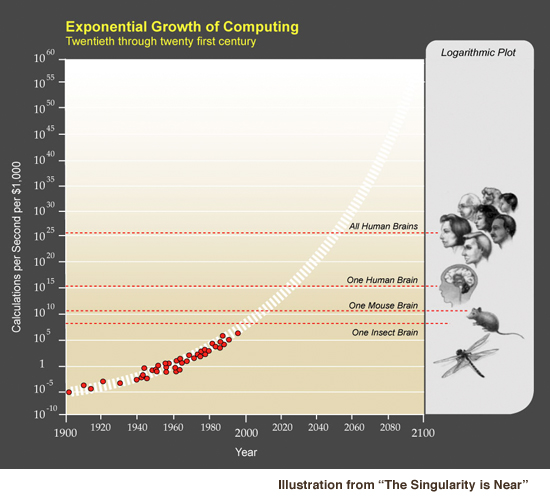 Ask people what the word “innovation” means to them and you’ll hear such phrases as, “…it’s all about making processes more efficient” or “…brainstorming new ideas and implementing them” or “…ways in which we can disrupt and leapfrog our competitors.” Clearly there are many ways to think about the process of innovation, but almost never do you hear entrepreneurs, business analysts or corporate strategists openly discussing the rate of change that’s occurring…
Ask people what the word “innovation” means to them and you’ll hear such phrases as, “…it’s all about making processes more efficient” or “…brainstorming new ideas and implementing them” or “…ways in which we can disrupt and leapfrog our competitors.” Clearly there are many ways to think about the process of innovation, but almost never do you hear entrepreneurs, business analysts or corporate strategists openly discussing the rate of change that’s occurring…
…and how that rate of change is accelerating exponentially.
 In his book, The World is Flat, Thomas Friedman pointed out an interesting premise that any linear, serial process can be outsourced, even if that process is at the PhD level in mathematics (and he illustrates the point by citing example after example of accounting, algorithim creation and other mathematics outsourcing occurring from Reuters to Wall Street). This can be done since linear and serial processes are defined and understood, and making them more efficient (or cheaper) or shortening cycle times is fairly straightforward. He also points out, “The further we push out the boundaries of knowledge and innovation, the more the next great value breakthroughs — that is, the next new hot-selling products and services — will come from putting together disparate things that you would not think of as going together.”
In his book, The World is Flat, Thomas Friedman pointed out an interesting premise that any linear, serial process can be outsourced, even if that process is at the PhD level in mathematics (and he illustrates the point by citing example after example of accounting, algorithim creation and other mathematics outsourcing occurring from Reuters to Wall Street). This can be done since linear and serial processes are defined and understood, and making them more efficient (or cheaper) or shortening cycle times is fairly straightforward. He also points out, “The further we push out the boundaries of knowledge and innovation, the more the next great value breakthroughs — that is, the next new hot-selling products and services — will come from putting together disparate things that you would not think of as going together.”
When one delves deeper in to innovation — especially if that individual is involved in a startup, initiative or major project — the experience of seeing the explosion of content on the web, thought leaders who’ve emerged and are connecting the dots openly in blogs or with other self-publishing means, conferences about innovation which have appeared in areas as diverse as manufacturing, medical and education, it’s easy to get overwhelmed by the exponential increases in information and data that has accelerated online and challenging to know where to turn for help. Especially if you’re a linear, serial thinker who moves forward in that way.
 Dealing with this onrush of information requires people who are suited to see changes in parallel and make associations (i.e., connect the dots) according to author Daniel Pink. In his book A Whole New Mind, Pink explores the move from the “Information Age” to the “Conceptual Age”, one demanding attributes people must possess in order to succeed in a world of accelerating change: “Lawyers. Accountants. Computer programmers. That’s what our parents encouraged us to become when we grew up. But Mom and Dad were wrong. The future belongs to a very different kind of person with a very different kind of mind. The era of “left brain” dominance, and the Information Age that it engendered, are giving way to a new world in which “right brain” qualities — inventiveness, empathy, meaning — predominate.” Pink also cites examples of parallel and associative leaps made by many people who’ve created value out of seemingly disparate pieces that, when combined, deliver much higher value in an innovative way.
Dealing with this onrush of information requires people who are suited to see changes in parallel and make associations (i.e., connect the dots) according to author Daniel Pink. In his book A Whole New Mind, Pink explores the move from the “Information Age” to the “Conceptual Age”, one demanding attributes people must possess in order to succeed in a world of accelerating change: “Lawyers. Accountants. Computer programmers. That’s what our parents encouraged us to become when we grew up. But Mom and Dad were wrong. The future belongs to a very different kind of person with a very different kind of mind. The era of “left brain” dominance, and the Information Age that it engendered, are giving way to a new world in which “right brain” qualities — inventiveness, empathy, meaning — predominate.” Pink also cites examples of parallel and associative leaps made by many people who’ve created value out of seemingly disparate pieces that, when combined, deliver much higher value in an innovative way.
Unfortunately for the linear and serial among us, the rate of change is exponential rather than linear change. As such, great leaps forward are occurring in all fields as people find ways to connect, associate and build upon one another’s thoughts, ideas and insights.
 One scientist who has detailed this exponential rate of change is Ray Kurzweil, inventor, entrepreneur and author of the book, The Singularity is Near. Kurzweil defines the Singularity, achieved in 2045, as a point in the future when technological advances begin to happen so rapidly that normal humans cannot keep pace, and are “cut out of the loop.” Kurzweil emphasizes that this will have a profound, disruptive effect on human societies and on everyday life as the internet, web and connected machines become increasingly ‘intelligent’ and surpass human beings as the smartest on the Earth. Technological development is taken over by the machines, who can think, act and communicate so quickly that normal humans cannot even comprehend what is going on.
One scientist who has detailed this exponential rate of change is Ray Kurzweil, inventor, entrepreneur and author of the book, The Singularity is Near. Kurzweil defines the Singularity, achieved in 2045, as a point in the future when technological advances begin to happen so rapidly that normal humans cannot keep pace, and are “cut out of the loop.” Kurzweil emphasizes that this will have a profound, disruptive effect on human societies and on everyday life as the internet, web and connected machines become increasingly ‘intelligent’ and surpass human beings as the smartest on the Earth. Technological development is taken over by the machines, who can think, act and communicate so quickly that normal humans cannot even comprehend what is going on.
It would be easy to simply laugh off Kurzweil’s premise as hyperbolic and unrealistic, if he wasn’t such an accomplished inventor, scientist and artificial intelligence thought leader, and that some aspects of the exponential rate of change is able to be measured, since Kurzweil lays out example-after-example in his book about how highly advanced technologies will arrive far sooner than linear-thinking people assume. The creation of the modern Internet and the completion of the Human Genome Project are two of the most prominent examples he uses to make his point.
EXPONENTIAL RATE OF CHANGE
 One key aspect of this exponential rate of change is caused by Moore’s Law, the premise that computer processing speed doubles every 18 months. As such, the capability of machines, increasing speeds of wired and wireless networks, proliferation of devices and chips within cars, appliances and even books — along with an acceleration in software which is created and delivered by global teams collaborating on its development — means that our ability to leverage ever more capable internet-connected machines for higher value creation is also increasing exponentially.
One key aspect of this exponential rate of change is caused by Moore’s Law, the premise that computer processing speed doubles every 18 months. As such, the capability of machines, increasing speeds of wired and wireless networks, proliferation of devices and chips within cars, appliances and even books — along with an acceleration in software which is created and delivered by global teams collaborating on its development — means that our ability to leverage ever more capable internet-connected machines for higher value creation is also increasing exponentially.
As the ability for any of us (thought leader or not) to participate in a globally connected world and collaborate, create and consume information and data, is being eyed by many whose revenues depend on accurate predictions of exponential growth. According to internet networking giant, Cisco’s, Visual Networking Index, the sheer volume of information and data online — increasingly available to us all regardless of the type of device we’re using or whether it’s connected with a wire or wireless — is nothing short of astounding “…global IP traffic in 2008 stands at more than 10 exabytes per month, more than quadrupling to approach 44 exabytes per month in 2012. Consumer IP traffic will exceed 32 exabytes per month, business IP traffic will approach 10 exabytes per month, and mobility traffic will exceed 1.2 exabytes per month.” (Note: 1 exabyte = 1,000,000,000 gigabytes (GB)).
How do we stay on top of all of that content? What do we pay attention to and to whom?
INNOVATING IN A TIME OF ACCELERATING CHANGE
So how does one manage the rate of change? Handle that flood of data? Hope to see all of the important and meaningful things to us, our business or organization, and see changes in parallel and be able to connect the dots?
These are huge questions beyond the scope of this post, but let me detail a few tools that exist to get you started as an individual:
- One of the most useful tools in one’s arsenal is the RSS (Really Simple Syndication) reader. While many choices exist, Google Reader is one of the most popular. Find thought leader blogs (Alltop is a great way to find top ones in the industry or space you’re working in) and subscribe to their RSS feed. Also, go to your industry’s online publications and find their RSS feed or make one for any website that doesn’t have one (e.g., Feed43, FeedYes, Feedity)
- Follow these thought leaders and publications on Twitter and periodically use Twitter search to query “tweets” from everyone in areas you’re interested in
- Start a blog and get a Twitter account. Connect with others in your area of interest or industry and begin to build more relationships this way than you’d ever be able to do in a world that used to be connected only by telephone, travel or postal services
- Map out all the places where thought leaders are congregating by discovering where the discussions and human connections are occurring (e.g., in one of the one million social network/affinity groups at Ning), and ensure that you (or your company strategists) are connected and paying attention to these places online.
Many conferences exist as well (and the ones below have RSS feeds of your area of interest which you can subscribe to in your RSS reader or online calendar making it simple to stay up-to-date):
- Find conferences in your area of interest or industry by searching for them on AllConferences (e.g., here’s just the internet category) and find some to attend
- Here is an events calendar at the University of Minnesota and, if you sign up, you can stay appraised of events using Upcoming
- From unconferences like our local Minnebar to corporate ones like The Front End to Innovation or education events listed at Classroom 2.0, there is no shortage of groups wrestling with innovation and creativity in a rapidly changing world.
As Wikipedia states in their article on innovation, “The term innovation means a new way of doing something. It may refer to incremental, radical, and revolutionary changes in thinking, products, processes, or organizations. A distinction is typically made between invention, an idea made manifest, and innovation, ideas applied successfully.”
I submit that our shift from old ways of value creation being primarily linear and serial in nature (and essentially incremental) toward a time when the new normal is radical and revolutionary change, means that all of us need to find ways to connect to others also trying to connect the dots, use tools that enable us to better handle exponential change, and understand that the root of innovation and higher level value creation is becoming more challenging by the day so we must pay attention and understand what is happening.
This is also an exciting time to be paying attention to innovation in the internet and web and all of the changes that are resulting from a world connected. Problem solving on a global scale is achievable in ways never before possible and predictions abound that we’ll live longer, solve the energy crisis while stopping global warming, and find new ways to correct or reverse many of the world’s biggest issues. It’s just that we all need to pay more attention, be aware of change that is moving at an exponential rate, and ensure that we’re finding the tools — and the people — who can see things in parallel and make associations to move you, your company or school, ahead as fast as the rest of the world is already moving.